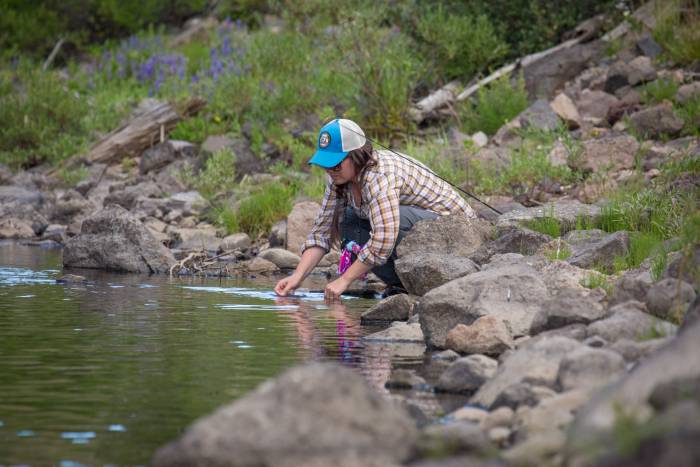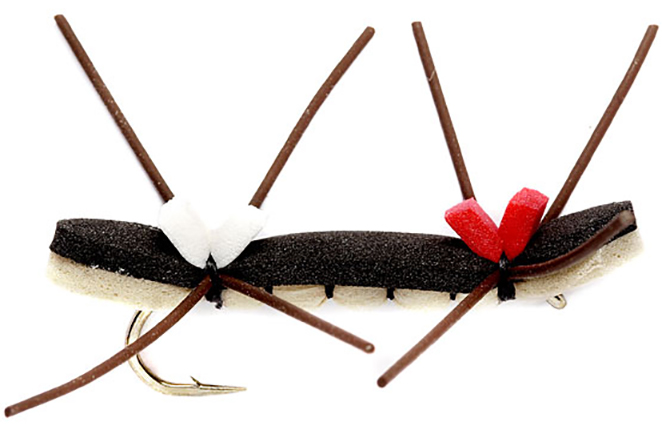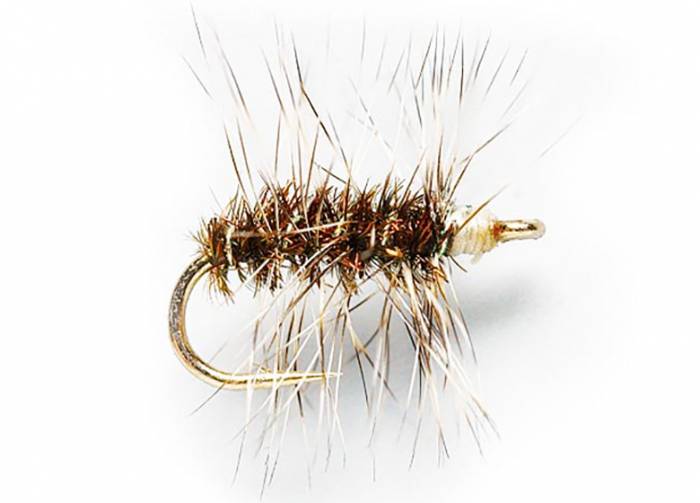Know these flies and techniques when most anglers are getting a little antsy with late-summer fly fishing conditions.
Terrestrial fishermen revel in the season, streamer lovers are busy preparing for cold fall mornings, and migratory fishermen begin planning their winter saltwater escape while also working to make the most of summer’s last gasp.
With a bit of thoughtful preparation, late summer can bring some of the year’s most productive fishing. Here are some of our favorite patterns to stow in the fly box.
Late-Summer Fly Fishing: Terrestrials
For many anglers, late summer is synonymous with terrestrial fishing. Fishing big, foamy hoppers, ants, and beetles fits well with the relaxed “dog days” vibe of late summer. It’s the perfect time of year to introduce new anglers to dry fly fishing, as these flies are hard to sink and easy to see on the water.
Chernobyl Ant
Kin to the Chubby Chernobyl — one of the most beloved terrestrial flies around — the Chernobyl Ant ($10) is a foam monster found in many fly boxes around the country. Ideal for fishing close to grassy banks on windy days, this ant is a winner for hungry trout.
Fish the Chernobyl Ant in a variety of ways; throwing it hard onto the water with a “splat!” (the way real ants hit the water) often incites a hard strike. And don’t be afraid to dead-drift it if a more active presentation isn’t working.
Black and tan (tan underbelly layered under black foam) is the most common coloring, and sizes range from 8 to 12.
Check Price at AmazonCheck Price at Orvis
Letort Hopper
The Letort Hopper ($3) is one of the oldest and best-known grasshopper patterns in the U.S. Designed by Pennsylvania’s Ed Shenk in 1960, this traditional pattern is a solid choice anytime hoppers are present. Be sure to coat it thoroughly in floatant, as the lack of foam means this hopper is naturally less buoyant than its foamy cousins.
This easy-to-tie hopper can be tied in a variety of neutral colors; tan is the most popular. Available in sizes 8, 10, and 12.
Check Price at OrvisTravis Para Ant
Ask any Montana fishing guide, and they’ll tell you that one of their favorite late-summer tactics is prospecting with ant patterns ($3). Tom Travis of Livingston, Mont., is wise to the power of these little creatures and so created this parachute ant.
The bright, parachute-style post on this pattern solves the common ant-fishing problem of hard-to-see flies, making it a great pattern for low light. Consider stocking up on both cinnamon and black in sizes ranging from 12 to 18.
Check Price at OrvisQuick-Sight Beetle
Another late-summer winner, beetle patterns appeal to a trout’s natural instincts. When there are terrestrials crawling on land, it’s well worth tying on a beetle pattern and, just like with ants and hoppers, plying grassy banks and shorelines.
The Quick-Sight Beetle ($2) is a very simple pattern — basically just foam, legs, and a hook — but features a bright-orange dot on the back to increase visibility, making it a good choice for evenings and low-visibility situations.
Black is the traditional beetle color and tends to be wickedly effective. If fish are snubbing hoppers and ants, tie one on and see what happens. Available in sizes 12-16; try to match size to the insects you see on shore.
Check Price at OrvisLate-Summer Season: Dry Flies
Trout often grow more selective later in the season. They’ve seen a lot of flies over the summer, the water temperature is higher, and the midday sun is often hyper bright. A strong arsenal of terrestrials may be the most popular option this time of year, but a range of dry flies can also prove productive.
Elk Wing Caddis
Arguably one of the most popular dry fly patterns of all time, the Elk Wing Caddis($2) has been proven time and time again. Imitating a natural caddis, a favored meal of trout, this fly can be drifted like a traditional dry fly but is also wickedly effective when skated across the top of the water.
Traditional colors for the Elk Wing Caddis include tan, olive, and gray, and the fly ranges in size from 10 to 20. Choose according to the presence and appearance of caddis on the water; this fly can also incite action even if no caddis are currently around.
Check Price at OrvisCheck Price at Amazon
Adams Parachute
Another classic, the Adams Parachute ($2) is a versatile basic every dry fly angler should keep on hand. Excellent for fishing rivers in a variety of conditions, it is also available in a popular purple iteration that can often bring a strike when fish are snubbing the more traditional colors.
Shop the classic in sizes 12-26 or the Adam’s Purple Parachute in sizes 12-18.
Check Price at OrvisCheck Price at Amazon
Griffith’s Gnat
Sometimes simple is best, as proven by the basic yet wildly effective design of the Griffith’s Gnat ($3). Designed to imitate a midge cluster, this fly can work as a “buggy-looking” dry fly and often encourage a strike when the fish seem to be turned off from everything else.
Fish it as a second fly behind a larger dry to cover all your bases. Available in natural colors in sizes 16-22.
Check Price at OrvisCheck Price at Amazon
Heat Considerations for Late Summer

Late summer can bring warmer water temperatures, so consider making the hike into high streams and lakes for fish who are more willing to eat. As water temperature rises, fish often move to water with increased oxygen. So look for them along seams near active riffles and in water that may seem a bit quicker than you’re used to fishing. Rise early, take a siesta midday, and stay out late.
And do the fish a favor — keep them in water and handle them as little as possible. Warmer water temperatures in late summer stress the fish. Strive to make the catch-and-release process faster and easier. Sometimes, in the dog days of summer, this can even mean choosing not to fish certain bodies of water. If the water temperature is 70 degrees Fahrenheit or higher, let the fish rest and then come back once cooler fall days come around.
















